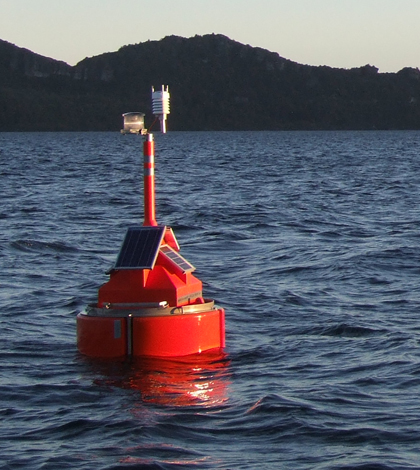New Rotorua Te Arawa Lakes data buoy tracks polymictic lake’s oxygen dynamics

A new data buoy launched this year in New Zealand’s Lake Rerewhakaaitu is providing scientists with insights into the polymictic lake’s oxygen dynamics and water column production. Polymictic lakes turn over many times per year.
The next-generation profiler is overseen by the Rotorua Te Arawa Lakes Programme and uses an automated winch to raise and lower sensors on a regular basis.
“The winch allows us to use a single package of water quality instruments to measure multiple depths through the water column,” said Chris McBride, technician at the University of Waikato who is helping the RTA Lakes Programme oversee the buoy. “Where a traditional buoy might measure high-frequency dynamics at just a few depths, a winch-based system allows us to better understand vertical dynamics.”
Some of the sensors that are helping investigators include a Eureka Manta II water quality multiprobe that tracks temperature, pH, dissolved oxygen, chlorophyll, phycocyanin fluorescence and turbidity. A Vaisala WXT520 is also mounted on the platform to measure weather parameters.
Scientists want to use those sensors to investigate issues unique to the lake. They don’t yet know if Rerewhakaaitu is more sensitive to anoxic events, says McBride, because of its iron-rich sediment. Loss of oxygen from the lake’s bottom may result in releases of phosphorus into the water above, and investigators at the RTA Lakes Programme also want to learn more about phytoplankton production in the water column.

A new data buoy launched in Lake Rerewhakaaitu is providing scientists with insights into oxygen dynamics. (Credit: Avenue, via Wikimedia Commons/CC BY 3.0)
“If the frequency and severity of anoxic events increases, it may result in a ‘tipping point’ where (phosphorus) load to the water column is greatly increased,” said McBride. “Therefore, understanding the frequency and severity of oxygen depletion is very important to the protection of water quality in Rerewhakaaitu.”
McBride says the data will also help support a variety of initiatives at the RTA Lakes Programme, and give a baseline understanding to scientists there who are planning more specific research or monitoring activities.
“Buoy data is extremely useful for establishing, calibrating and validating computer ecosystem models,” said McBride. Those models, he says, are oftentimes used to assess possible management actions taken to treat lakes in the region, like land-use adjustments and sediment treatments.
All data collected by the buoy will be shared with the Global Lake Ecological Observatory Network, and illustrate the conditions of a changing lake. “High-frequency data is particularly useful in polymictic lakes, where traditional water quality sampling does not adequately capture important lake processes which can occur at sub-monthly timescales,” said McBride. “Lake Rerewhakaaitu is polymictic and therefore a priority for installation of a monitoring buoy.”
Top image: Buoy deployed in Lake Waikaremoana. (Credit: Chris McBride)





0 comments